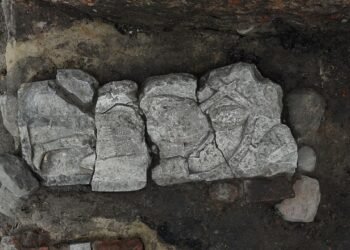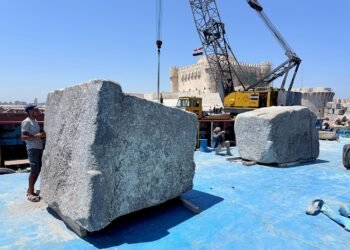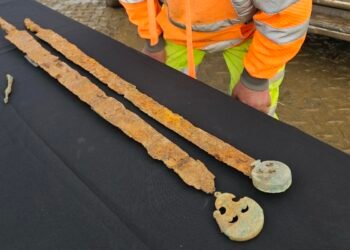During construction work at Burghley House, an esteemed English country estate located near Stamford, Lincolnshire, a Roman marble sculpture, consisting of a head and bust, was unearthed.

The discovery, made by Greg Crawley, a diligent digger driver, unfolded unexpectedly as the bucket of his machine rolled over what initially appeared to be an ordinary stone. To his astonishment, the “stone” revealed itself to be the exquisitely carved head of a Roman statue, a relic from the 1st or 2nd century CE.
“I had a real shock as the digger bucket rolled over what I thought was a big stone to reveal a face,” recalled Crawley. “When I picked it up, I realized it was a head of a statue. I couldn’t believe it when they told me it was a Roman marble statue. It was an amazing feeling to have found something so old and special – definitely my best-ever discovery.”
Further exploration led to the unearthing of a marble bust, believed to have been attached to the head. Experts promptly dated the sculpture to the First or Second Century, with an iron dowel later affixed to enable its attachment to a pedestal or bust. Such modifications were commonplace among Italian antiquities dealers during the late 18th Century, aimed at enhancing the allure of excavated relics for aristocrats embarking on the Grand Tour.
The origins of the sculpture remain shrouded in mystery, with speculation ranging from accidental burial to deliberate concealment. It is presumed that the sculpture might have been acquired by Brownlow Cecil, 9th Earl of Exeter, during one of his tours to Italy in the 1760s, a period marked by significant acquisitions of antiquities. However, the circumstances surrounding its burial and subsequent discovery remain unclear.
Following meticulous cleaning and restoration efforts by professional conservators, the head and bust have been reassembled, restoring the sculpture to its former glory. Plans are underway to display the artifact prominently within Burghley House, alongside an explanation detailing its remarkable journey from excavation to restoration. The find has also been reported to the British Museum, contributing to the broader understanding of Roman art and culture in Britain.
Now, as Burghley House prepares to welcome visitors for the 2024 season, these newfound treasures will take their place of honor alongside other sculptures acquired by the ninth Earl. When Burghley House reopens for the season on March 16th, the sculpture will be showcased on the dramatic Hell Staircase.























